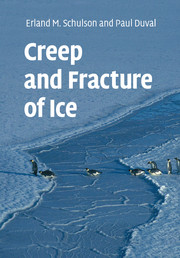Book contents
- Frontmatter
- Contents
- Preface
- Acknowledgements
- 1 Introduction
- 2 Structure of ice
- 3 Microstructure of natural ice features
- 4 Physical properties: elasticity, friction and diffusivity
- 5 Plastic deformation of the ice single crystal
- 6 Ductile behavior of polycrystalline ice: experimental data and physical processes
- 7 Modeling the ductile behavior of isotropic and anisotropic polycrystalline ice
- 8 Rheology of high-pressure and planetary ices
- 9 Fracture toughness of ice
- 10 Brittle failure of ice under tension
- 11 Brittle compressive failure of unconfined ice
- 12 Brittle compressive failure of confined ice
- 13 Ductile-to-brittle transition under compression
- 14 Indentation fracture and ice forces on structures
- 15 Fracture of the ice cover on the Arctic Ocean
- Index
- References
6 - Ductile behavior of polycrystalline ice: experimental data and physical processes
Published online by Cambridge University Press: 01 February 2010
- Frontmatter
- Contents
- Preface
- Acknowledgements
- 1 Introduction
- 2 Structure of ice
- 3 Microstructure of natural ice features
- 4 Physical properties: elasticity, friction and diffusivity
- 5 Plastic deformation of the ice single crystal
- 6 Ductile behavior of polycrystalline ice: experimental data and physical processes
- 7 Modeling the ductile behavior of isotropic and anisotropic polycrystalline ice
- 8 Rheology of high-pressure and planetary ices
- 9 Fracture toughness of ice
- 10 Brittle failure of ice under tension
- 11 Brittle compressive failure of unconfined ice
- 12 Brittle compressive failure of confined ice
- 13 Ductile-to-brittle transition under compression
- 14 Indentation fracture and ice forces on structures
- 15 Fracture of the ice cover on the Arctic Ocean
- Index
- References
Summary
Introduction
Understanding how polar ice sheets interact with the climatic system is of the highest importance to predict sea-level changes. Ice sheets contain information on the climate and the atmospheric composition over the last 800 000 years (EPICA Community Members, 2004). Interpretation of ice core data is directly dependent on the accuracy of ice sheet flow models used for ice core dating. Knowledge of the rheological properties of ice in the low stress conditions of glaciers and polar ice sheets is therefore needed to improve the constitutive laws that are incorporated in flow models. Due to very high viscoplastic anisotropy of the crystal (Chapter 5), ice is considered as a model material to validate micro-macro polycrystal models used to simulate the behavior of anisotropic viscoplastic materials (Gilormini et al., 2001; Lebensohn et al., 2007).
Ice displays a wide range of mechanical properties, including elasticity, visco-elasticity, viscoplasticity, creep rupture and brittle failure (Schulson, 2001). In glaciers and ice sheets, ice is generally treated as a heat-conducting non-linear viscous fluid.
Ice is assumed here to be incompressible. It will be shown that the main effect of hydrostatic pressure on the ductile behavior of ice is to modify the melting temperature of pure ice Tf with dTf /dP ≈ 0.074 ℃/MPa (Lliboutry, 1971).
In this chapter, we focus the analysis on the mechanical behavior of granular glacier ice. We assume that the behavior is ductile without the formation of cracks.
Information
- Type
- Chapter
- Information
- Creep and Fracture of Ice , pp. 101 - 152Publisher: Cambridge University PressPrint publication year: 2009
References
Accessibility standard: Unknown
Why this information is here
This section outlines the accessibility features of this content - including support for screen readers, full keyboard navigation and high-contrast display options. This may not be relevant for you.Accessibility Information
- 2
- Cited by
